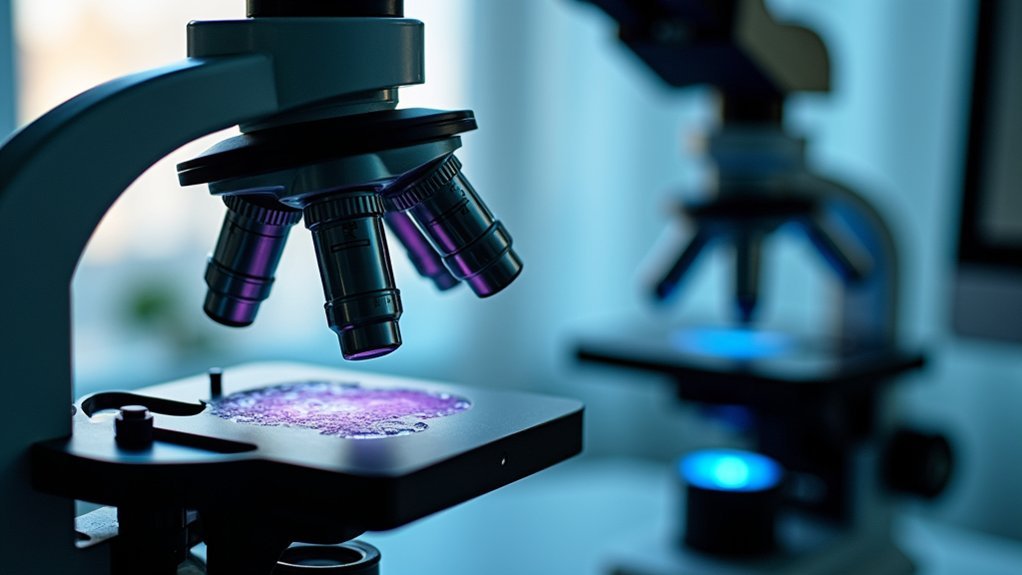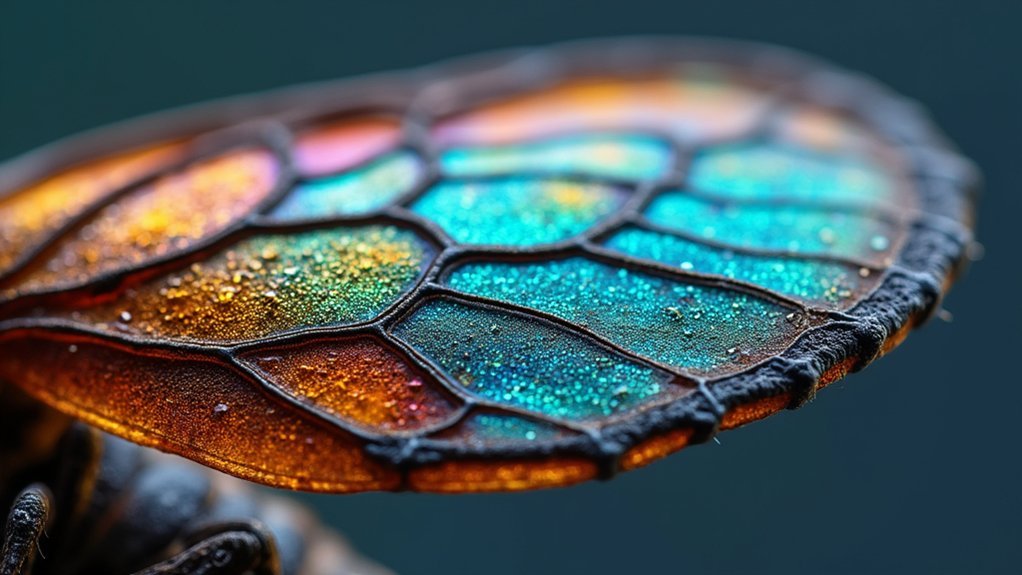Optical magnification preserves image quality by physically adjusting lenses, maintaining resolution across all zoom levels. Digital magnification merely crops and enlarges pixels, causing quality degradation, especially at higher zoom factors. For maximum photo resolution, prioritize optical zoom up to the diffraction limit (approximately 200 nanometers), as exceeding this threshold produces blurrier images despite powerful lenses. When necessary, combine both methods—use optical zoom first, then apply minimal digital enhancement. The technical nuances of this relationship reveal surprising advantages for your photography.
The Fundamentals of Optical and Digital Magnification

When exploring photo resolution, understanding the stark contrast between optical and digital magnification is essential.
Optical zoom works through physical lens movements that adjust focal length, preserving image quality across all zoom levels. This process utilizes your camera’s entire sensor, maintaining clarity even at higher magnifications.
The mechanics of optical zoom preserve the integrity of your image through actual lens adjustments, not digital shortcuts.
Digital zoom, however, is merely a software trick that crops and enlarges the center portion of your image. It doesn’t capture additional detail but instead stretches existing pixels, often resulting in noticeable quality degradation and pixelation.
The magnification capabilities of your camera are typically expressed as ratios (like 3x or 10x).
With optical zoom, these numbers represent genuine enhancement of detail. Digital zoom, while convenient, ultimately sacrifices resolution by discarding peripheral information and enlarging what remains.
Resolution Limitations in Microscope Photography
Microscope photography takes magnification to an entirely different scale compared to conventional photography.
When you’re capturing microscopic subjects, your images face several resolution limitations determined by both optical and digital factors. The optical system’s numerical aperture (NA) ultimately defines how much detail you can physically capture.
Here’s what impacts your microscope photography resolution:
- Optical system quality – higher NA values (up to 1.4) enable capturing structures as small as 200 nanometers.
- Digital magnification challenges – cropping and enlarging images reduces actual detail preservation.
- Sensor capabilities – higher megapixel sensors better maintain quality during digital enhancement.
- Lighting techniques – proper illumination helps reveal fine details that would otherwise be lost.
Understanding these resolution limitations helps you maximize your microscope photography results while avoiding unrealistic expectations.
How Optical Magnification Preserves Image Integrity

Unlike digital zoom which merely crops and enlarges existing pixels, optical magnification preserves the integrity of your images through genuine physical lens adjustments.
When you use optical zoom, your camera lens physically moves to bring subjects closer while utilizing the entire image sensor, maintaining consistent resolution throughout the zoom range.
You’ll notice the difference with a 3x optical zoom that effectively brings subjects from 30 feet to 10 feet without sacrificing detail.
Professional photographers rely on this true magnification capability when image quality is non-negotiable.
The optical zoom ratio (such as 3x or 5x) directly indicates your lens’s magnification power, ensuring you achieve proper framing without compromising resolution.
For situations where detail matters, optical zoom delivers the sharp, high-quality visuals you need.
Digital Magnification: Enhancing vs. Interpolating
Digital magnification attempts to increase image size through pixel adding techniques that crop and enlarge portions of your photo, but you’ll notice quality deterioration as resolution diminishes.
Your camera’s software uses interpolation to estimate new pixel values, creating the illusion of detail where none existed in the original capture.
While this approach offers convenience without additional lenses, you’re fundamentally trading image integrity for magnification as digital zoom amplifies noise and reduces clarity, particularly in challenging lighting conditions.
Pixel Adding Techniques
When photographers need to magnify images beyond their camera’s optical capabilities, they often turn to pixel adding techniques. Unlike optical zoom, digital zoom relies on interpolation to estimate new pixel values based on existing data. Your camera’s sensor resolution greatly affects the outcome—higher pixel count sensors produce better results when digitally magnified.
Here’s what happens when using pixel adding techniques:
- Your original image gets cropped to isolate the central portion.
- The cropped section is enlarged to fill the frame, reducing the effective pixel count (often from 24MP to under 10MP).
- Interpolation algorithms generate new pixels between existing ones to maintain apparent resolution.
- Advanced AI processing attempts to intelligently reconstruct lost details, though still inferior to optical zoom.
Despite technological improvements, these techniques inevitably compromise image quality compared to true optical magnification.
Quality Preservation Challenges
While attempting to maximize resolution through digital techniques, you’ll inevitably face significant quality preservation challenges.
When you use digital zoom, your camera crops and enlarges the center portion of your image, resulting in pixelation as your megapixel sensor’s data gets stretched beyond its native resolution.
Interpolation attempts to mitigate this issue by estimating missing pixel information, but it creates artifacts that degrade image quality.
Even with high-resolution sensors, you’ll notice digital zoom produces less detailed images than optical zoom, particularly in low light where noise becomes more pronounced.
Your camera’s megapixel count directly impacts how effective digital magnification can be—higher counts provide more data to work with, but still can’t match optical zoom’s clarity and detail preservation.
Digital Zoom Limitations
Unlike optical zoom, your camera’s digital zoom function merely creates the illusion of magnification by cropping and enlarging a portion of your image.
This process inherently degrades image quality as your camera interpolates pixels to fill the gaps, resulting in reduced resolution and clarity.
The limitations of digital zoom become evident in these scenarios:
- Resolution drop – your 24MP camera might deliver less than 10MP of actual detail when digitally zoomed
- Visual artifacts – interpolation creates unnatural patterns that weren’t in the original scene
- Low-light performance – digital zoom amplifies noise, dramatically reducing image quality in dim conditions
- Ineffective enhancement – no matter how sophisticated, digital algorithms can’t recreate detail that wasn’t captured
While high-resolution sensors help mitigate some losses, they can’t match optical zoom’s uncompromised quality.
Calculating Maximum Effective Resolution in Microscopy
Although many microscope users focus primarily on magnification levels, the maximum effective resolution determines what details you’ll actually see in your specimens. This resolution is calculated using the formula d = 0.61 × λ / NA, where λ represents light wavelength (typically 550 nm) and NA is the numerical aperture of your lens.
You’ll find that optical quality greatly impacts your effective resolution. A microscope with superior optics at 400x magnification might reveal more detail than a lower-quality 1000x instrument. This explains why chasing higher magnification numbers alone won’t guarantee better results.
While digital zoom can enhance visibility of certain features, it doesn’t improve actual resolution. Remember that excessive digital magnification often creates pixelation without revealing new details.
For ideal results, prioritize numerical aperture and optical quality over raw magnification numbers.
The Abbe Diffraction Limit and Its Impact on Magnification

Even as you invest in high-resolution cameras and powerful lenses, you’ll eventually encounter the Abbe diffraction limit—a fundamental physical boundary that constrains what details you can capture.
This physical law restricts resolution to approximately half the wavelength of light used, meaning visible light photography can’t resolve details smaller than about 200 nanometers.
When you increase magnification, particularly with optical zoom, diffraction becomes more significant:
- Higher magnification amplifies diffraction effects, potentially reducing image quality
- Exceeding the diffraction limit results in blurrier images despite using more powerful lenses
- The relationship between wavelength and numerical aperture determines your maximum achievable resolution
- Understanding this limit helps you make informed choices between optical zoom techniques and digital enhancement
The diffraction limit isn’t a flaw in your equipment—it’s physics setting boundaries on what’s possible.
Sensor Size and Pixel Density Considerations
When you’re evaluating a camera’s maximum resolution capabilities, sensor size and pixel density create a fundamental yet often misunderstood relationship. Many assume that more megapixels automatically translate to better resolution, but this oversimplifies the reality.
Larger sensors capture more light, delivering superior image quality and dynamic range, especially in challenging conditions. However, pixel density matters too—cramming too many pixels onto a small sensor often increases noise and reduces clarity, particularly at smaller apertures where diffraction becomes an issue.
Bigger sensors capture more light, but excessive pixel density on small sensors compromises image quality, especially at narrow apertures.
For best results, you’ll want to balance these factors. A larger sensor with moderate pixel density typically outperforms a smaller sensor with extremely high pixel density.
Remember that true resolution depends not just on pixel count but also on your lens quality and the sensor’s ability to resolve detail effectively.
Comparing Image Quality at Different Magnification Levels

When you examine photos at higher magnification levels, you’ll immediately notice the stark difference between optical zoom’s clarity and digital zoom’s pixelation.
Your camera’s optical zoom preserves detail by physically adjusting the lens, maintaining resolution throughout the entire zoom range.
In contrast, digital zoom fundamentally crops your image and stretches the remaining pixels, dramatically reducing detail retention as magnification increases.
Clarity vs. Pixelation
As you magnify an image, the difference between optical and digital zoom becomes strikingly apparent.
Optical zoom preserves clarity through physical lens adjustments, maintaining image quality regardless of zoom level. Digital zoom, however, relies on cropping and interpolation, which inevitably leads to pixelation as you push beyond native resolution.
When comparing results at increasing magnification levels:
- At 2x zoom, optical maintains full resolution while digital begins showing subtle quality loss.
- At 3x zoom, optical images remain crisp while digital shows visible degradation.
- At 5x zoom, optical still delivers professional-quality results while digital images appear noticeably grainy.
- At 10x zoom, the optical advantage becomes overwhelming, with digital images suffering severe pixelation.
You’ll always achieve superior results with optical zoom when detail preservation matters.
Detail Retention Analysis
Three critical factors determine how much detail your photos retain at higher magnification: sensor resolution, zoom type, and processing quality.
When you compare optical zoom with digital zoom, the differences become striking.
Optical zoom preserves image quality through physical lens adjustments, maintaining your camera’s full resolution regardless of magnification level. A 3x optical zoom delivers crisp images while its digital counterpart produces grainy, blurred results.
You’ll notice this distinction dramatically when comparing a 4MP camera using optical zoom against digital zoom—the optical method utilizes the entire sensor while digital zoom crops and discards valuable pixels.
Even with a high-resolution 24MP sensor, digital zoom can’t match optical zoom’s detail retention. The physics of optical magnification simply outperforms the mathematical interpolation of digital zoom for maximum photo resolution.
Technical Challenges of High-Magnification Microscopy
Despite advances in imaging technology, high-magnification microscopy faces several fundamental limitations that can frustrate even experienced researchers. When you’re pushing beyond conventional magnification levels, you’ll encounter the diffraction barrier that severely restricts optical resolution, preventing you from distinguishing closely spaced structures.
- Higher numerical aperture (NA) objectives improve light collection but can’t completely overcome diffraction’s physical constraints.
- Sample preparation artifacts often become more pronounced at extreme magnifications, distorting true structural features.
- Digital magnification simply enlarges existing pixels, leading to pixelation and degraded image quality without adding real detail.
- Super-resolution microscopy techniques like STED and PALM offer promising solutions by circumventing traditional optical limits, but require specialized equipment and expertise.
Equipment Selection for Optimal Microscopic Resolution

Overcoming the challenges of high-magnification microscopy begins with selecting the right equipment for your imaging needs. You’ll want to prioritize microscopes with high-quality optical zoom capabilities that maintain image clarity through physical lens adjustments, rather than relying on digital zoom which degrades resolution.
| Equipment Factor | Importance | Impact on Resolution |
|---|---|---|
| Optical Zoom | Critical | Preserves detail through true magnification |
| Lens Quality | High | Minimizes distortion and aberrations |
| Sensor Resolution | Medium | Supports digital zoom when necessary |
Look for systems offering optical zoom ratios above 10x for flexibility across various specimens. Remember that while higher megapixel counts help with digital zoom, your magnification range should primarily depend on quality objective lenses compatible with your specific research or inspection requirements.
Post-Processing Techniques for Microscope Images
Post-processing your microscope images with contrast enhancement methods will reveal subtle details that remain hidden in raw captures.
You’ll find noise reduction workflows essential for cleaning up grainy textures that often plague high-magnification photography, especially in low-light conditions.
Focus stacking techniques allow you to combine multiple images taken at different focal planes, creating a single composite with exceptional depth-of-field that’s otherwise impossible to achieve with microscopy’s inherently shallow focus.
Contrast Enhancement Methods
When examining microscope images, you’ll often find that raw captures lack the contrast needed to reveal critical details.
Contrast enhancement methods can dramatically improve image clarity without sacrificing the authenticity that optical zoom provides, something digital zoom simply can’t match.
To enhance microscope image contrast effectively:
- Apply histogram equalization to redistribute pixel intensities, making previously hidden structures visible.
- Use gamma correction to fine-tune midtones, revealing subtle features that remain obscured in low-contrast areas.
- Implement unsharp masking to accentuate edges, bringing fine biological details into focus.
- Utilize adaptive techniques like CLAHE that enhance local contrast while preventing noise amplification.
These approaches let you extract maximum detail from your microscope images without resorting to excessive digital zoom, which only enlarges pixels rather than revealing authentic detail or clarity.
Noise Reduction Workflows
Despite capturing images at high magnification, microscope photography often suffers from electronic noise that masks the very details you’re trying to observe. To counter this, you’ll need effective noise reduction techniques in your post-processing workflow.
Common methods include Gaussian blur, median filtering, and wavelet thresholding—each helping to smooth noise while preserving structural integrity. When using Adobe Photoshop or specialized microscopy software, you can apply selective noise reduction to significant areas, protecting essential features.
Measure your success by evaluating the signal-to-noise ratio (SNR), which quantifies useful information relative to background interference.
Focus Stacking Techniques
Microscope images often struggle with limited depth of field, where only one focal plane appears sharp while others blur—a challenge that persists even with ideal noise reduction.
Focus stacking overcomes this limitation by combining multiple high-resolution images captured at different focal depths into a single composite image with enhanced overall sharpness.
To achieve successful focus stacking:
- Capture a series of images with your microscope, adjusting focus slightly between each shot.
- Guarantee consistent lighting and exposure settings throughout the sequence.
- Process your images using specialized software tools like Helicon Focus or Adobe Photoshop.
- Review the final composite and make manual adjustments where necessary.
This technique dramatically increases depth of field without sacrificing detail, allowing you to produce microscope images where both foreground and background elements remain crisp and clear.
Practical Applications of Combined Magnification Methods
By leveraging both optical and digital zoom technologies together, photographers can access a considerably expanded range of creative possibilities.
When you’re capturing wildlife or distant subjects, start with optical zoom to maintain image quality, then apply digital zoom judiciously for that extra reach. Modern photography often demands this dual approach.
Your smartphone likely employs this technique already—switching between multiple lenses for optical zoom while filling gaps with digital zoom functionality.
During video conferencing or live streaming, you can utilize this combined approach to frame your subject perfectly without sacrificing clarity.
The key is understanding when to rely on each method—optical zoom for maintaining resolution in the initial capture, digital zoom for enhancing specific details when your high-resolution sensor can support it without significant degradation.
Frequently Asked Questions
Which Is Better Optical Zoom or Digital Zoom?
Optical zoom is better than digital zoom. You’ll get true magnification while preserving image quality. Digital zoom simply crops and enlarges pixels, resulting in lower resolution and noticeable quality loss.
Is Optical Zoom the Same as Magnification?
No, they’re not identical. Optical zoom is a process that achieves magnification by changing focal length. While magnification refers to making subjects appear larger, optical zoom is specifically how cameras accomplish this physically.
What Is 40X Optical Zoom Equivalent To?
A 40x optical zoom means your camera’s maximum focal length is 40 times greater than its minimum. If your lens starts at 25mm, you’ll get 1000mm maximum reach without losing image quality.
What Does 30X Optical Zoom Mean?
30X optical zoom means your camera’s lens physically magnifies objects to 30 times their original size. You’ll capture detailed images from far distances without losing quality, as the lens elements move to achieve this magnification.
In Summary
You’ll notice optical magnification always preserves your image’s actual resolution, while digital zoom merely stretches existing pixels. For maximum photo quality, invest in superior optical components first, then apply minimal digital enhancement. Remember that every imaging system has theoretical limits—no amount of magnification can reveal details smaller than your equipment’s resolving power. Balance both techniques for practical microscopy that meets your specific research needs.





Leave a Reply